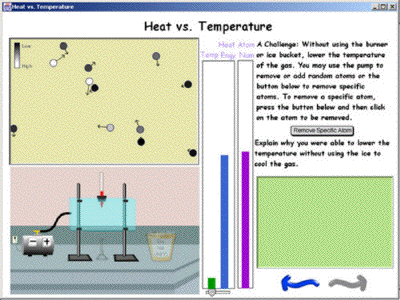
MW2D or other applications can appear in a window in Pedagogica along with other windows that may contain text, buttons, and other Java or Flash applications, as illustrated. We have, for instance, used this to show macroscopic views illustrated with Flash that are coordinated with microscopic views generated by MW2D to model phase changes at the atomic level that are mirrored with an illustration that changes between gas, liquid, and solid.

|
| A hypermodel incorporating a Flash animation (lower left) that is coordinated with the model. Students can investigate the effect of removing only fast or cold atoms. The MW2D model in the upper left, as well as the bar graphs in the middle all respond appropriately to the changes students cause. |
We have elected to execute hypermodels on client computers. This is because the models require considerable computational resources and because good connectivity is not always accessible to students, either due to travel, poor home access, or unreliable school networks. We made the decision to support Flash in Pedagogica because it simplifies authoring animations. We use animations extensively to illustrate the macroscopic representation of a system in coordination with a microscopic representation generated by MW2D. Executing Flash within Pedagogica required creating many of the basic graphics capacities used by Flash in Java.
Pedagogica is controlled by a script that can be written either in EASL, our homegrown Educational Application Scripting Language, or JavaScript. Both are object-oriented. Some graphical programming aides have been developed to simplify screen layout and sequencing pages. Pedagogica monitors events generated by the model and can use these to collect implicit assessment data about student progress through the activity as well as explicit assessment data from student answers to questions. These data can be time-stamped and given XML tags. Student activities written for Pedagogica can be easily changed to fit our research and, as we learn more, to fit the needs of different students.